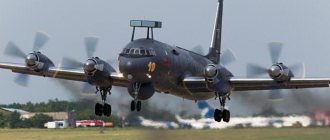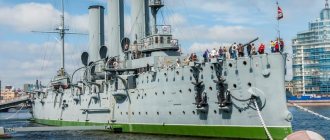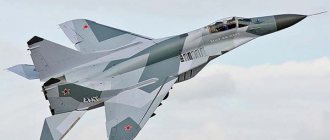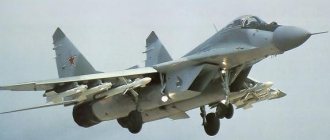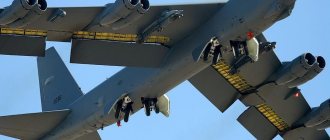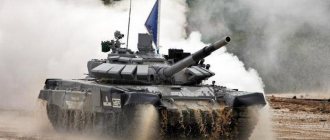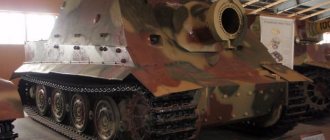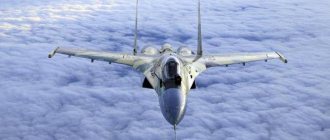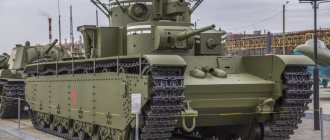History of the creation of the BOD
In the 70s, countries with navies came to the conclusion that building ships specialized for a specific task was too expensive. Therefore, it was decided to build multi-purpose ships, including by Soviet designers. Thus was born Project 1155 to create a multi-purpose ship.
However, some production and technical problems stood in the way of this idea. And yet, at the end of the 80s, the USSR began work on Project 1155, the result of which was to become a large anti-submarine ship.
V.P. Mishin was entrusted with leading the work. After the delivery of the lead BOD in this series, the Udaly, to the fleet, Mishin took up issues of modernizing this series. The first design sketches presented a completely different ship, outwardly similar to the Udaloy, but still different from it.
But that was the first impression. The main innovations were hidden from prying eyes. The hull contained a modern power plant, a powerful hydroacoustics complex, a general air defense control system for the ship and other combat systems created on a digital element base. At its core, it was a new project aimed at the US destroyers Orly Burke and Spruance.
According to the chief designer of Project 1155, V.P. Mishin, the Soviet multi-purpose ship was in no way inferior to the American Orly Burke, and in some matters could even give it a head start.
At the end of 1992, the BOD was launched. According to tradition, he was named after one of the famous Soviet naval commanders.
General information
Project 11356 patrol ships
Built in the USSR in the 1970s and 1980s, India's series of five Rajput-class destroyers are still in service. The outstanding characteristics of the Soviet project 61M on which they were based, as well as the caring attitude of their new owners, ensured their long active service. It should also be noted that timely upgrades make it possible to maintain the combat capabilities of these ships at the proper level. The high assessment given to this project in India was also expressed in the fact that it was on its basis that, with the help of Soviet specialists, Delhi-class destroyers were designed, which were already being built at Indian shipyards.
Who does the ship owe its name to?
The large anti-submarine ship owes its name to the commander of the Northern Fleet, A. T. Chabanenko, who held this position from 1952 to 1962.
Andrei Trofimovich was born in Ukraine on October 17, 1909. From his youth he linked his fate with the navy. After naval school, he served as an officer on submarines of the Black Sea Fleet.
At the age of 24, he was entrusted with command of a submarine in the Pacific Fleet. Five years later, he already had a submarine division under his command, and in 1940, a brigade.
At the age of 35, Chabanenko received the rank of rear admiral.
After the war, Andrei Trofimovich takes academic courses at the Naval Academy and is appointed commander of the Yuzhno-Sakhalin naval base. At the end of 1947, the officer was sent to the General Staff Academy. After graduation, he took command of the Northern Fleet.
During the period of command of the fleet, Chabanenko did a lot of work on the deployment of naval bases, developed submarine tactics and worked them out practically, prepared and conducted the first polar voyages of nuclear submarines.
Legislation
The issues of assigning pension payments to retirees are regulated by the following acts:
- Constitution of the Russian Federation. Article 13 of the Basic Law sets out the norms, the implementation of which leads to the assignment of a pension.
- Federal Law N 4468-1 of February 12, 1993 Specific rules for calculating long-service benefits have been established.
The Constitution of the Russian Federation states the fundamental right of a person to receive support from the state in the event of loss of ability to work. Reforming the OPS system does not violate such norms. But a lot of amendments will have to be made to the federal law.
For information: President of the Russian Federation V.V. In 2022, Putin announced an increase in pensions for retired military personnel. The increase occurred from 01/01/18. Payments were indexed by 4.1%. However, the Moscow Region is implementing a program to systematically increase payments to retirees. Pensions should be increased to 100% of salary by 2035. In December 2022, the President of the Russian Federation signed a law on increasing military pensions after October 2022. After this date, the pensions of military and security forces will be calculated based on 73.68% of the pay of active military personnel/departmental employees. The overall increase in pension provision will be 6.3%.
What changes are planned to be made to the law?
The bill, which is being discussed in the State Duma, upon closer examination promises soldiers more benefits than losses. The developers offer the following:
- increase the period of compulsory service to 25 years;
- replace the indicator of 12.5 years when assigning maintenance for a mixed length of service for 20 years;
- introduce bonuses for officers and soldiers for each year of military work.
Thus, it is indeed planned to increase the age of retirement with subsequent receipt of support from the budget of the RF Ministry of Defense. Such a change is quite rational. Huge amounts of money are spent on training highly qualified military specialists. And at 45 years old, a man is at the very peak of activity, as evidenced by the parameters of retirement in countries around the world.
But the developers went further in creating regulatory conditions for attracting citizens to military work. Thus, it is proposed to amend Law No. 306-FZ of November 7, 2011. This regulatory act regulates the calculation of monetary allowances to soldiers. It is planned to include a clause regulating the accrual of additional payments for military service:
In addition, it is proposed to add an additional clause to the normative act. It contains a rule about accruing 25% of the expected pension to soldiers:
- who have reached retirement age;
- those remaining in the ranks of the Armed Forces.
The bill on raising the military retirement age contains clauses that compensate citizens for the change in conditions. In addition, it is proposed to include in the law a provision on the right of officers to retire according to the old version (if desired). That is, everyone who served in the Armed Forces will be able to apply for a pension upon reaching 20 years of service. The innovations will affect officers and soldiers who will join the army after the changes are made.
For information: the stated edition may be changed in the process of discussion and expert analysis.
Specifics of calculations
Pensioners, as a rule, are interested in the amount of future accruals. Let's consider the bill from this point of view. The current law has rules for limiting the maintenance of retirees. With 20 years of service, the payment to a pensioner is calculated at 50% of the salary for the corresponding position. At the same time, for each year of work above the norm, an increase of 3% is due. The maximum age benefit is limited to 85% of the salary.
The bill increases the starting position for 25 years of experience to 65%. For each year above the norm, the same 3% is due. But the maximum position is 95% of the monetary allowance. This means that a retiree’s pension may increase under the new rules.
The increase in the basic rate applies only to general cases of retirement. Different rules are established for officers leaving their positions on preferential terms. It is proposed to leave these unchanged:
- reaching the maximum possible age;
- deterioration of health confirmed by a military medical commission (disability);
- regular events.
Beneficiaries are expected to leave the base rate of pension accrual at 50% of their salary for 20 years of service. And 3% for each year above the norm. The upper limit is the same 95%.
For information: the logic of the new law suggests that it will be more profitable for soldiers and officers to remain in their positions than to retire.
Mechanism for assigning pensions to female military personnel
For women military personnel, pensions are calculated on the same basis as for men. Military service must be at least 20 years.
But the legislation provided certain benefits:
- If a woman has not reached the maximum age for service (45 years), then she has the right to receive a long-service pension.
- Women are not subject to dismissal, except in cases specified by law.
For information: in 2022, there are no plans to increase the length of service for women.
State tests
In 1995, the Admiral Chabanenko BPC was launched for sea trials, the delivery of which lasted for many years. Their financial support quickly dried up, and the ship was laid up against the wall for several years.
Only the intervention of the Commander-in-Chief of the Russian Navy, Admiral Kuroyedov, moved the issue forward. Financing issues were resolved immediately. State tests were carried out at the highest level. Everything needed arrived as quickly as possible.
The Baltic Fleet allocated a submarine, surface ships, and aircraft to test the tactical and technical data of the new BOD. All types of firing were carried out, all systems were tested, including air defense (air defense). Air defense was checked by flying all types of aircraft over the ship. Ka-27 helicopters successfully checked the compliance of the takeoff and landing sites with the standards.
After the successfully completed epic with state tests, the ship was sent to the Northern Fleet for further service.
Technical equipment and characteristics of the ship
“Admiral Chabanenko” is a ship capable of autonomous navigation for 30 days. Movement can be carried out in two modes: marching and afterburning. For this purpose, the BOD is equipped with two-shaft gas turbine power plants of the COGAG type: two sustainer M-63 9 thousand liters each. With. and two afterburners M8KF of 22 thousand liters each. With.
Power plants allow you to develop a maximum speed of 32 knots. In economy mode, the speed is 18 knots.
The standard displacement of the ship is 7700 tons, the total displacement is 8900 tons.
The distance from bow to stern of the Admiral Chabanenko is 163.4 m. The width of the vessel is 19.5 m.
At the stern there are two take-off and landing pads for anti-submarine helicopters of the Ka-27 type.
The ship's crew consists of 296 people.
Propulsion system
From the very beginning, two options for the main power plant were considered - a traditional steam turbine (STU) and a gas turbine (GTU). The latter, due to its lightness and compactness (specific weight 5.2 kg/hp versus 9 kg/hp), reduced the ship's displacement from 3600 to 3200 tons and increased efficiency. In addition, starting from a cold state took 5-10 minutes for a gas turbine compared to several hours required for a steam turbine. For these reasons, the option with gas turbine engines was adopted.
Because of the melodious whistle of gas turbines, the ships of the series were dubbed “singing frigates” by the navy.
The bow and stern engine rooms occupied one compartment each. Each housed an all-mode main gas turbine gear unit (GGTZA) M-3 with a capacity of 36,000 hp. With. produced by the Southern Turbine Plant in Nikolaev, two gas turbine generators GTU-6 with 600 kW each and a diesel generator DG-200/P with 200 kW. The compartments between the compartments were occupied by auxiliary mechanisms (roll stabilizer, auxiliary boilers). The fuel was stored in double-bottom tanks with a capacity of 940 tons, 70 tons of fresh water for the crew and 13 tons of water for auxiliary boilers were also stored there.
The total power of the power plant was 72,000 liters. With. Each GTZA consisted of two irreversible gas turbine engines (GTE) with a power of 18,000 hp each. With. with reversible mating gearbox. Each gas turbine engine had its own gas outlet pipe. Each of the two shafts had a four-bladed fixed-pitch propeller.
The use of gas turbines required the adoption of measures to reduce noise, which included a noise absorption system in air intake shafts, shock absorption of mechanisms, and sound-absorbing coatings. The engines were controlled remotely from special posts located in the power plant premises.
The anchor device consisted of two Hall anchors. The steering wheel is semi-balanced.
Modernization of weapons of the Project 1155 anti-submarine ship
When designing the ship, the designers tried to take into account the shortcomings of the Udaly BOD, created under Project 1155.
First of all, attention was paid to weapons. As a result, two 100 mm caliber artillery mounts were abandoned, replacing them with a twin 130 mm mount. The anti-submarine missile system "Metel" was replaced with the anti-ship missile system "Moskit".
The 533 mm TA was replaced with the Vodopad anti-submarine missile system.
Anti-aircraft weapons were strengthened by the Kortik anti-aircraft missile system. The 30mm AK-630 mount was removed from the project.
The Polynom hydroacoustic complex (GAS) was also replaced by the more advanced Zvezda-2.
Armament of the BOD project 1155.1
The BOD has modern weapons, reflecting its multi-purpose nature.
First of all, this is the Vodopad-NK with two missile and torpedo launchers - an anti-submarine complex.
The missiles of the complex are controlled by the GAK hydroacoustic complex. They have two types of warheads: the 84R/RN missile is a depth charge with a nuclear warhead, and the 83R/RN is a small-sized universal torpedo.
The complex is capable of hitting a target at a distance of 37-50 km.
The Boa constrictor-1 complex protects the ship from enemy torpedoes and saboteurs. It is represented by a 10-barreled rocket and bomb launcher, which has a device for automatic loading and unloading.
Targeting is carried out by the GAK. The target is neutralized at a range of 3 km and a depth of up to 600 m with 111СО, 111СЗ, 111СГ projectiles.
The Kinzhal air defense missile launcher is a multi-channel autonomous complex. Capable of protecting a ship from a massive air attack. Its versatility in hitting any air targets, from aircraft to guided and unguided bombs, is admirable.
The Kinzhal uses the multifunctional radar of the S-300F air defense system. In this case, target designation is received by the complex from any ship radar. It is capable of hitting up to four targets in a 60-degree sector.
The Admiral Chabanenko BOD is equipped with the Kortik anti-aircraft missile and artillery system. The complex protects the ship from precision weapons and aircraft. It can be used to destroy small targets at sea and on land.
The complex is fully automated. Its range of action depends on the type of target and the weapons used and is 4-8 km.
Literature
- Apalkov Yu. V.
Ships of the USSR Navy. Directory in 4 volumes. - St. Petersburg: Galeya Print, 2003. - Vol. II, part I. Aircraft-carrying ships. Rocket and artillery ships.. - 124 p. — ISBN 5-8172-0080-5. - Apalkov Yu. V.
Ships of the USSR Navy. Directory in 4 volumes. - St. Petersburg: Galeya Print, 2005. - T. III. Anti-submarine ships. Part I. Large anti-submarine ships. Patrol ships. — 124 s. — ISBN 5-8172-0094-5. - Apalkov Yu. V.
Anti-submarine ships. - Morkbook. - M., 2010. - P. 147. - 310 p. — 1000 copies. — ISBN 978-5-903080-99-1. - Pavlov A. S.
Udaloy type BOD. - Yakutsk, 1997. - 40 p. — ISBN not specified. - Conway's All the World's Fighting Ships, 1947-1995. - Annapolis, Maryland, USA: Naval Institute Press, 1996. - ISBN 1557501327. Archived copy dated November 1, 2008 on the Wayback Machine
Electronic weapons of the ship
Modern Russian anti-submarine ships are blind and deaf without electronic weapons.
This concept covers various systems that provide navigation, detection and targeting of missiles, warning of laser irradiation, etc.
For example, the combat information and control system (CIUS) "Lesorub-55" serves to automatically generate recommendations to the crew on the most effective use of the capabilities of the ship and its weapons.
The Fregat-MA radar station monitors the air and surface space around the BOD. Having detected targets, it issues a command to fire weapons to repel the enemy attack. Works effectively even with intense radio countermeasures.
The ship is also equipped with the Corvette control system, Kurs-10A-1 and Kurs-10A-2 gyrocompass systems.
The Kristall communications complex and the Pritsel-A space communications station provide communications in any conditions. The Pritsel-A station made it possible to have a stable connection with anywhere in the world.
Classification Features
Unfortunately, the quantity of information posted on the Internet most often does not translate into quality. Obvious proof of this thesis is the chronic confusion observed in the description of large anti-submarine ships of projects 1155 and 1155.1. In particular, these BODs are periodically called frigates, referring to the “NATO classification”.
This is what a “real” frigate looks like – the American USS Simpson. Displacement - only 4200 tons
This is a gross mistake - in Western reference books, large first-class anti-submarine ships (and projects 1155 and 1155.1 are exactly that) are most often called destroyers, less often - cruisers. In addition, the very concept of “class of ships” in the West means belonging to a specific series, built according to a single project. The class name is assigned by the name of the lead ship. In this case it was “Udaloy”. That is why in the real, and not fictitious, NATO classification, all Project 1155 BODs are called Udaloy, and Project 1155.1 BODs are called Udaloy II.
In the USSR, and later in Russia, the term "class" was used to designate the "intended" purpose of a ship (for example, the "destroyer" class). Belonging to the series was indicated either by the project number or by “type”. In the latter case, the name of the lead ship was used.
At the same time, in the documentation, Project 1155 was designated by the code “Fregat”, which, apparently, led to subsequent confusion. Meanwhile, any code is simply an internal conventional name applied to the drawings and has nothing to do with the intended purpose of the ship.
Service in the Northern Fleet of the Russian Navy
From the moment of acceptance to this day, the Admiral Chabanenko BPC has been guarding the northern sea borders of Russia as part of the Northern Fleet under number 650.
During its service, the Admiral Chabanenko demonstrated the high level of training of its crew during exercises. The exercises took place not only as part of Russian naval formations, but also with foreign ships (for example, the VENRUS-2008 exercises).
Repeatedly visited foreign ports as part of a courtesy visit.
From November 2009 to April 2010, he guarded civilian ships in the Gulf of Aden.


